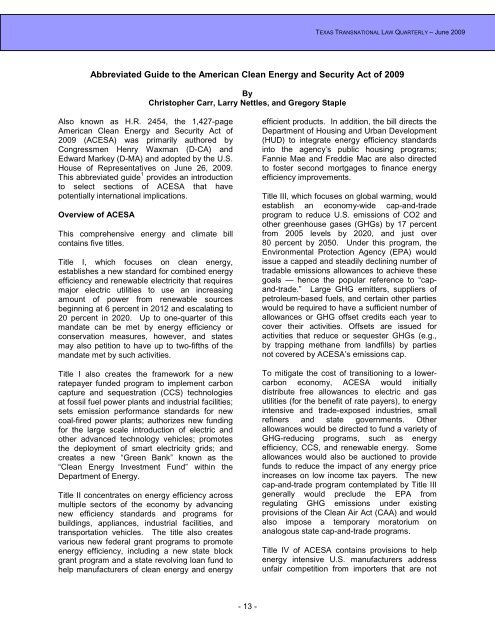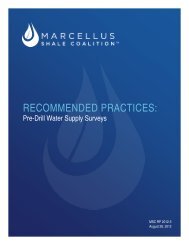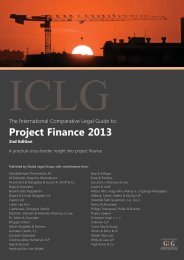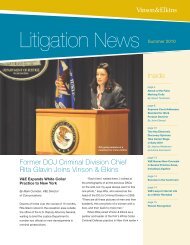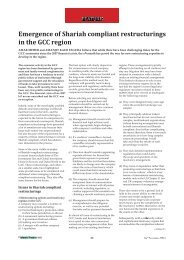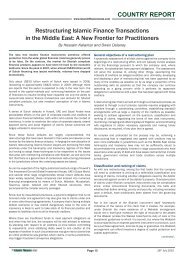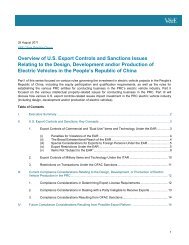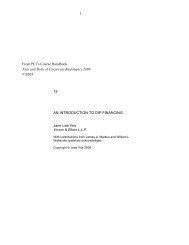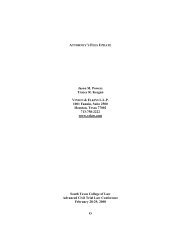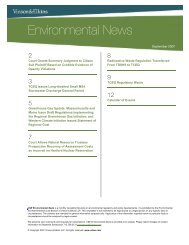TEXAS TRANSNATIONAL LAW QUARTERLY - Vinson & Elkins LLP
TEXAS TRANSNATIONAL LAW QUARTERLY - Vinson & Elkins LLP
TEXAS TRANSNATIONAL LAW QUARTERLY - Vinson & Elkins LLP
You also want an ePaper? Increase the reach of your titles
YUMPU automatically turns print PDFs into web optimized ePapers that Google loves.
<strong>TEXAS</strong> <strong>TRANSNATIONAL</strong> <strong>LAW</strong> <strong>QUARTERLY</strong> – June 2009Abbreviated Guide to the American Clean Energy and Security Act of 2009ByChristopher Carr, Larry Nettles, and Gregory StapleAlso known as H.R. 2454, the 1,427-pageAmerican Clean Energy and Security Act of2009 (ACESA) was primarily authored byCongressmen Henry Waxman (D-CA) andEdward Markey (D-MA) and adopted by the U.S.House of Representatives on June 26, 2009.This abbreviated guide 1 provides an introductionto select sections of ACESA that havepotentially international implications.Overview of ACESAThis comprehensive energy and climate billcontains five titles.Title I, which focuses on clean energy,establishes a new standard for combined energyefficiency and renewable electricity that requiresmajor electric utilities to use an increasingamount of power from renewable sourcesbeginning at 6 percent in 2012 and escalating to20 percent in 2020. Up to one-quarter of thismandate can be met by energy efficiency orconservation measures, however, and statesmay also petition to have up to two-fifths of themandate met by such activities.Title I also creates the framework for a newratepayer funded program to implement carboncapture and sequestration (CCS) technologiesat fossil fuel power plants and industrial facilities;sets emission performance standards for newcoal-fired power plants; authorizes new fundingfor the large scale introduction of electric andother advanced technology vehicles; promotesthe deployment of smart electricity grids; andcreates a new “Green Bank” known as the“Clean Energy Investment Fund” within theDepartment of Energy.Title II concentrates on energy efficiency acrossmultiple sectors of the economy by advancingnew efficiency standards and programs forbuildings, appliances, industrial facilities, andtransportation vehicles. The title also createsvarious new federal grant programs to promoteenergy efficiency, including a new state blockgrant program and a state revolving loan fund tohelp manufacturers of clean energy and energyefficient products. In addition, the bill directs theDepartment of Housing and Urban Development(HUD) to integrate energy efficiency standardsinto the agency’s public housing programs;Fannie Mae and Freddie Mac are also directedto foster second mortgages to finance energyefficiency improvements.Title III, which focuses on global warming, wouldestablish an economy-wide cap-and-tradeprogram to reduce U.S. emissions of CO2 andother greenhouse gases (GHGs) by 17 percentfrom 2005 levels by 2020, and just over80 percent by 2050. Under this program, theEnvironmental Protection Agency (EPA) wouldissue a capped and steadily declining number oftradable emissions allowances to achieve thesegoals — hence the popular reference to “capand-trade.”Large GHG emitters, suppliers ofpetroleum-based fuels, and certain other partieswould be required to have a sufficient number ofallowances or GHG offset credits each year tocover their activities. Offsets are issued foractivities that reduce or sequester GHGs (e.g.,by trapping methane from landfills) by partiesnot covered by ACESA’s emissions cap.To mitigate the cost of transitioning to a lowercarboneconomy, ACESA would initiallydistribute free allowances to electric and gasutilities (for the benefit of rate payers), to energyintensive and trade-exposed industries, smallrefiners and state governments. Otherallowances would be directed to fund a variety ofGHG-reducing programs, such as energyefficiency, CCS, and renewable energy. Someallowances would also be auctioned to providefunds to reduce the impact of any energy priceincreases on low income tax payers. The newcap-and-trade program contemplated by Title IIIgenerally would preclude the EPA fromregulating GHG emissions under existingprovisions of the Clean Air Act (CAA) and wouldalso impose a temporary moratorium onanalogous state cap-and-trade programs.Title IV of ACESA contains provisions to helpenergy intensive U.S. manufacturers addressunfair competition from importers that are not- 13 -


